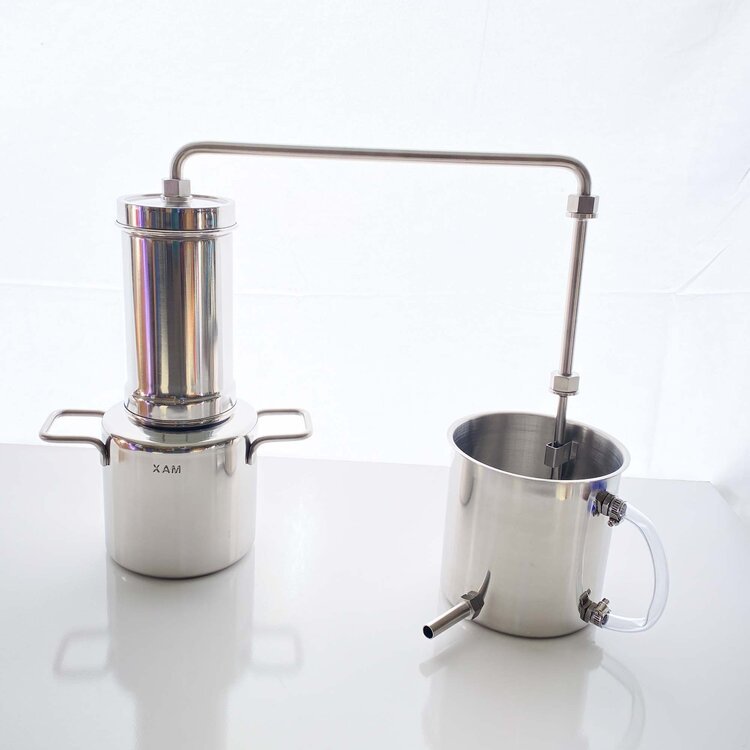How to use Steam Essential Oil Distiller?
Are you looking for a way to extract essential oils from plants and herbs for personal use or business? Steam distillation is the most common method used to extract essential oils, and with the right equipment, it's easy to do at home.
Steam distiller is a reliable and efficient tool that can help you easily extract essential oils from your favorite plants. In this article, you will learn the step-by-step process of using the steam essential oil distiller.
Let's read!
What is Steam Distillation?
Steam distillation is a process of extracting essential oils from plants and herbs using steam. It is a popular method for producing high-quality and pure essential oils. In steam distillation, plant material is placed in a still and exposed to steam. Steam passes through the plant material, which releases the essential oil into the steam, which is then carried by the steam into a condenser.
The steam in the condenser is cooled and converted back into a liquid. The liquid has two phases. One is the water phase which is called hydrosol. For example, the steam distillation product from rose flowers is rose hydrosol or rosewater. The other is oil phase which is essential oil. The essential oil is then collected and stored in a separate container. Steam distillation is a gentle and non-invasive method that ensures that the essential oil retains its natural properties and aroma.
This process is commonly used for extracting essential oils from various plants and herbs, such as lavender, peppermint, eucalyptus, and rosemary. The quality and quantity of the essential oil produced depend on multiple factors, such as the plant material used, the amount of herbs distilled, the steam pressure and temperature, and the duration of the distillation process.
What is a Steam Essential Oil Distiller?
A steam essential oil distiller is a device that extracts essential oils from plants and herbs through the process of steam distillation. It works by using steam to heat the plant material, resulting in the essential oils being released and evaporating. The steam and essential oils are then condensed into a liquid form, which can be collected and used for various purposes.
Steam essential oil distillers are widely used by people interested in creating their essential oils. They provide a safe and efficient way to extract high-quality, pure essential oils from plants and herbs.
They come in various sizes, ranging from small tabletop models to large industrial-sized distillers. The products from steam distillation including hydrosols and essential oils are commonly used in aromatherapy, herbal medicine, and natural skincare products.
Here you can have the best option for an oil distiller machine.
How to Extract Essential Oil using a Steam Distillation Kit?
Following are the steps for extracting essential oil using a steam distillation kit:
● Choose the Plant Material: The plant material is the source of essential oil, so it's crucial to choose a suitable material. The plant material should be fresh or dry and of high quality. Avoid using wilted, damaged or spoiled plants, as they may affect the quality of the oil. Additionally, the amount of oil that can be extracted varies between plants. Some plants, such as lavender, peppermint, and eucalyptus, have a higher oil yield and are popular choices for steam distillation.
● Set up the Steam Distillation Kit: Steam distillation kits are available in various sizes and designs, but they typically consist of a steam generator, a distillation flask, and a condenser. Always follow the manufacturer's instructions to assemble the kit properly. Ensure all the parts are clean and dry before starting to prevent contamination and ensure accurate results.
● Add Water to the Steam Generator: Distilled or filtered water should be used in the steam generator. Using tap water may introduce impurities, such as chlorine disinfectant, that can affect the quality of the oil.
● Add the Plant Material to the Flask: Add the plant material to the distillation flask, ensuring it's not too tightly packed. That will allow the steam to flow freely and extract the essential oil.
● Connect the Kit: Attach the steam generator and condenser to the distillation flask. The steam will pass through the plant material and extract the essential oil. The condenser is used to cool the steam and condense the essential oil and hydrosol.
● Heat the Water: Place the steam generator on a heat source, such as a hot plate or stove, and heat the water until it starts to boil, which will release steam to rise from the generator and pass through the plant material.
● Collect the Essential Oil: As the steam passes through the plant material, the volatile compounds within the herbs will vaporize. The steam carrying the essential oil will then pass through the condenser, cool down and condense into a liquid. This liquid will collect in the collection flask or separator. The amount of essential oil collected depends on the quality and quantity of the plant material and the length of the distillation process.
● Separate the Essential Oil from Hydrosol: Once you have collected it, you need to separate it from the hydrosol. You can use an essential oil hydrosol separator or separating funnel to do this. Essential oils are less dense than water and will float on top of it. The separator will allow you to separate the oil while collecting the hydrosol.
● Store the Essential Oil: Once you have separated it, store it in a dark glass bottle in a cool, dry place away from direct sunlight. Label the bottle with the plant's name and the extraction date. Essential oils are volatile and can vaporize quickly if not stored properly. It's important to use the oil within a year or so to ensure maximum potency.
Tips for Steam Distillation:
● Always use fresh or dry and high-quality plant material.
● Distilled or filtered water should be used in the distillation steam generator.
● Do not overheat the water, as it may cause the plant material to burn or produce unwanted compounds.
● Always use heat-resistant gloves and goggles when handling the distillation kit.
● It's essential to clean all the parts of the steam distillation kit, including pot, container, tubing and coil, after each use to prevent contamination and ensure accurate results.
FAQs
How Do You Steam Distill Essential Oils?
To steam distill essential oils, you need to heat water in a distillation steam generator until it boils and produces steam, which passes through the plant material and extracts the essential oil. The steam carrying the essential oil then condenses and is collected in a separate container. The essential oil is then separated from the hydrosol and stored in a dark glass bottle.
How Do You Use Essential Oil Steam?
To use essential oil steam, add a few drops of essential oil to a bowl of hot water, cover your head with a towel, and inhale the steam for several minutes. The hot steam will help release the essential oil's aromatic molecules into the air, allowing you to breathe them in and enjoy their therapeutic benefits. It's vital to choose high-quality essential oils and to use caution when using hot water to avoid burns or injuries.
How Do You Perform a Steam Distillation?
Choose the plant material from which you want to extract the essential oil.
Place the plant material in a distillation flask and add distilled or filtered water then heat the water to boiling using a heat source.
As the water boils, the steam passes through the plant material and vaporizes the essential oil.
The steam containing the essential oil then passes through a condenser, where it is cooled and condensed into a liquid.
The liquid containing the essential oil will be collected in a separate container.
The essential oil can be separated from the hydrosol and stored in a dark, glass bottle in a cool, dry place.
How Do You Extract Lavender Oil from Steam Distillation?
To extract lavender oil from steam distillation, add fresh or dried lavender flowers to a distillation flask with distilled or filtered water. Dried lavender flowers can produce more oil than fresh ones due to its lower moisture content. Heat the water until it boils, resulting in steam passing through the lavender flowers and vaporizing its essential oil. The essential oil steam then passes through a condenser, where it cools and condenses into a liquid. The resulting mixture of essential oil and lavender hydrosol is then separated using an essential oil hydrosol separator, and the essential oil is collected and stored in a dark glass bottle.

